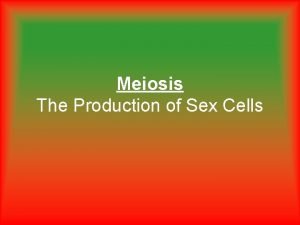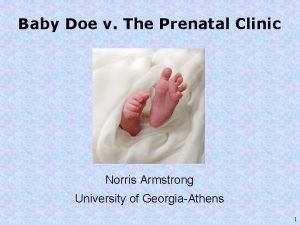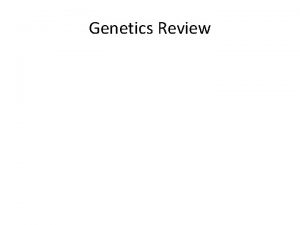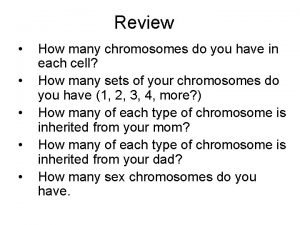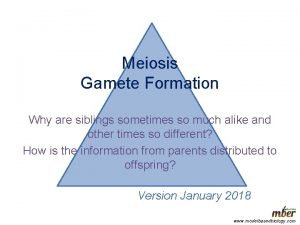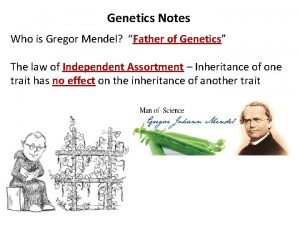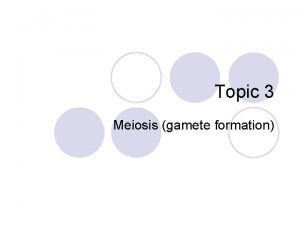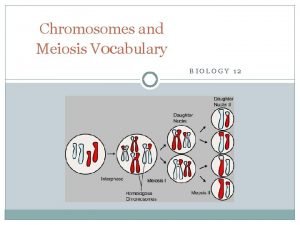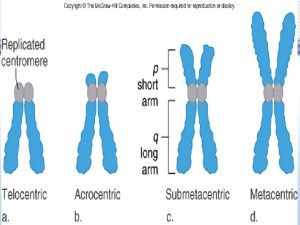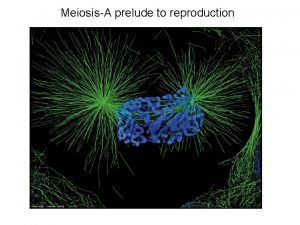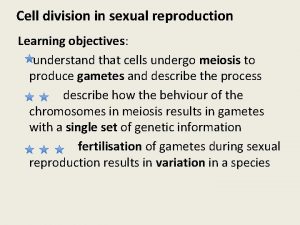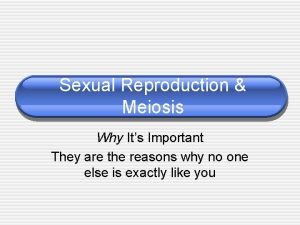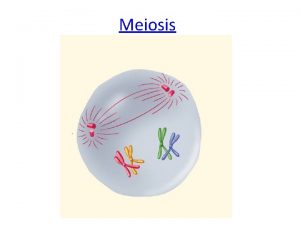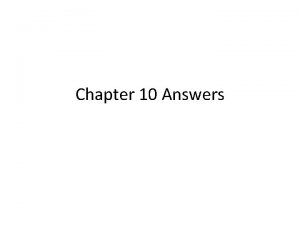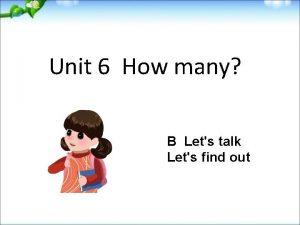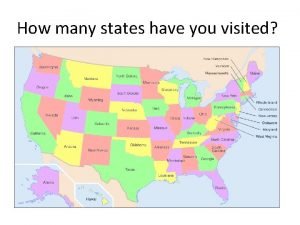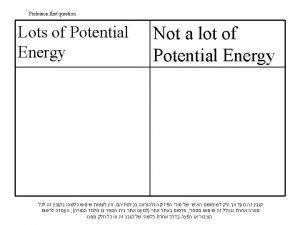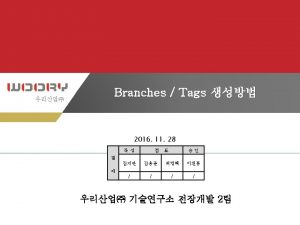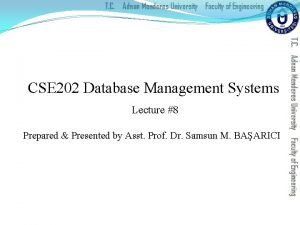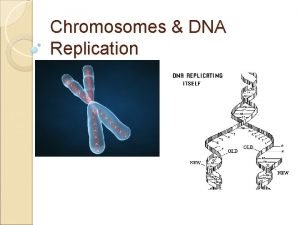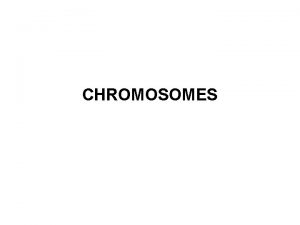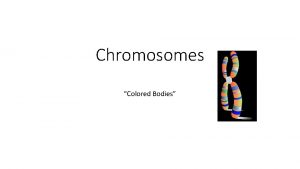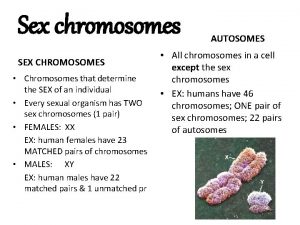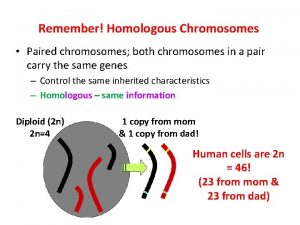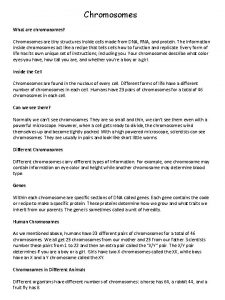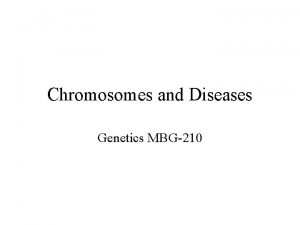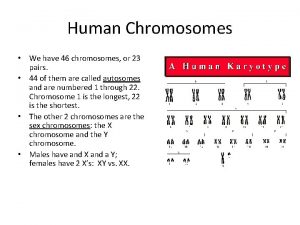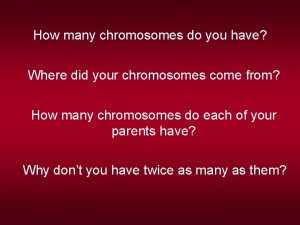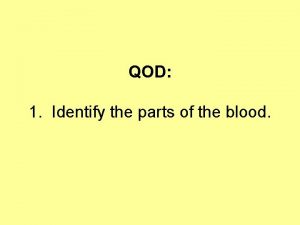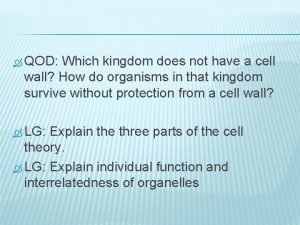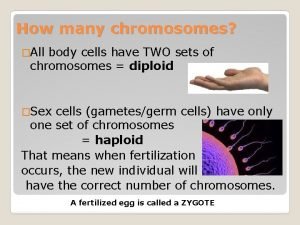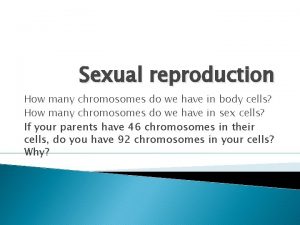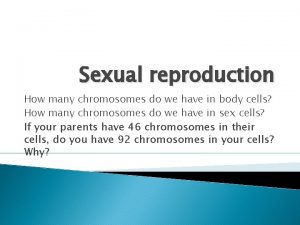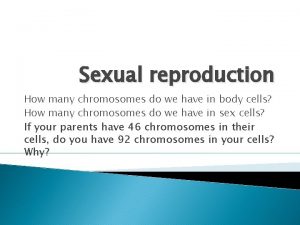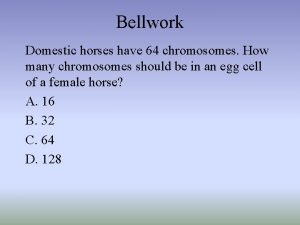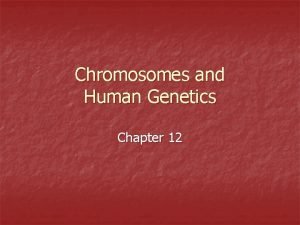QOD How many chromosomes do you have Identify









































- Slides: 41

QOD How many chromosomes do you have? Identify them. How many from your father? Mother?

Chapter 8: Cell Reproduction Section 8 -1: Chromosomes

Chromosome Structure To return to the chapter summary click escape or close this document.

Chromosome Structure u Chromosomes = DNA + Proteins u Levels of organization: – DNA – Nucleosome = DNA + Histones – Coils – Supercoils – Chromosome

Chapter 8 Section 1 Chromosomes Chromosome Structure

Chromosome To return to the chapter summary click escape or close this document.

Chromosomes u Before Cell Division – Chromatin – Thinned out u During Cell Division – Thickened – Chromosomes u Chromatids u Centromere (2)

Chromosome Types and Numbers u Types: – Sex chromosomes – Autosomes – Homologous chromosomes – Karyotype u Numbers: – Diploid (2 n) – Haploid (n)

Karyotype

Karyotype

QOD How many chromosomes does a skin cells have after it divides by mitosis? What happens to ensure this number is achieved? When?

Chapter 8: Cell Reproduction Section 8 -2: Cell Division

Cell Division u In Prokaryotes – Binary fission u In Eukaryotes – Mitosis – Meoisis

Chapter 8 Section 2 Cell Division in Prokaryotes

QOD Define mitosis. What is the end result of mitosis?

Stages of Cell Cycle To return to the chapter summary click escape or close this document.

III. The Cell Cycle u Interphase – G 1 –S – G 2 u. M Phase – Mitosis – Cytokinesis

The M phase u Mitosis – Division of the nucleus – Prophase – Metaphase – Anaphase – Telophase u Cytokinesis cytoplasm – Division of the

Mitosis

Animal cell undergoing mitosis To return to the chapter summary click escape or close this document.

Prophase u Nucleus disappears u Centrosomes/Centrioles move u Spindle fibers form – mitotic spindle – Kinetochore fibers/ Kinetochore – Polar fibers

Mitosis continues u Metaphase – Metaphase plate u Anaphase – Role of kinetochore u Telophase – Reversal of prophase – Results:

QOD How does the cell control the cell cycle? What happens when control is lost?

Animal cell undergoing mitosis To return to the chapter summary click escape or close this document.

Plant Cell Undergoing Mitosis To return to the chapter summary click escape or close this document.

Cytokinesis u Division of the cytoplasm u Separates two nuclei into two distinct daughter cells u Animal cells – cleavage u Plant cells – form cell plate

Control of Cell Division u Checkpoints: – G 1 – G 2 – Mitosis u Loss of control – Cancer

QOD Compare and contrast mitosis to meiosis

Chapter 8: Cell Reproduction Section 8 -3: Meiosis

Homologous Chromosome To return to the chapter summary click escape or close this document.

Meiosis u “Reduction” division u Produces gametes u 2 divisions u Diploid haploid u Fertilaztion – n + n = 2 n

Meiosis Diagram To return to the chapter summary click escape or close this document.

Meiosis I u Prophase I – Much of it same as prophase in mitosis u Nucleus/nucleolus disappears u Chromosomes coil u Centrioles and spindle fibers – Homologous chromosomes pair up u Synapsis u Forms a tetrad u Crossing-over genetic recombination

Crossing Over Diagram To return to the chapter summary click escape or close this document.

QOD What is independent assortment?

Meiosis I u Metaphase I – Tetrads line up u Anaphase I – Independent assortment genetic variation u Telophase I – Cytokinesis begins – Forms 2 haploid cells

LE 13 -8 ab MEIOSIS I: Separates homologous chromosomes METAPHASE I PROPHASE I ANAPHASE I Sister chromatids remain attached Centromere (with kinetochore) Sister chromatids Chiasmata Metaphase plate Spindle Tetrad Homologous chromosomes (red and blue) pair and exchange segments; 2 n = 6 in this example Microtubule attached to kinetochore Tetrads line up Homologous chromosomes separate Pairs of homologous chromosomes split up

Meiosis II u No copying of DNA u Follows process of mitosis u Prophase II u Metaphase II u Anaphase II u Telophase II u Cytokinesis

LE 13 -8 b MEIOSIS II: Separates sister chromatids TELOPHASE I AND CYTOKINESIS PROPHASE II Cleavage furrow Two haploid cells form; chromosomes are still double METAPHASE II ANAPHASE II Sister chromatids separate TELOPHASE II AND CYTOKINESIS Haploid daughter cells forming During another round of cell division, the sister chromatids finally separate; four haploid daughter cells result, containing single chromosomes

Results u Gametes – 4 haploid cells – Genetically different u Males: – Spermatogensis u Females: – Oogenesis – 1 egg cell, 3 polar bodies

Chapter 8 Section 3 Meiosis in Male and Female Animals
 Qod drug
Qod drug 23 chromosome pairs
23 chromosome pairs How many chromosomes does a human have
How many chromosomes does a human have How many chromosomes do humans have
How many chromosomes do humans have What did gregor mendel do
What did gregor mendel do How many chromosomes do prokaryotes have
How many chromosomes do prokaryotes have Modelbasedbiology
Modelbasedbiology What happens if you have 45 chromosomes
What happens if you have 45 chromosomes It is not you they have rejected but me
It is not you they have rejected but me How many chromosomes in a human
How many chromosomes in a human How many pairs of chromosomes
How many pairs of chromosomes Too many chromosomes
Too many chromosomes Meiosis terminology
Meiosis terminology How many cells
How many cells How many chromosomes are in a human's sex cells
How many chromosomes are in a human's sex cells Meiosis
Meiosis Section 11-4 meiosis answers
Section 11-4 meiosis answers What shape has 8 vertices 12 edges and 6 flat faces
What shape has 8 vertices 12 edges and 6 flat faces Your silver watch band masses out at 326g
Your silver watch band masses out at 326g How many students does your school have
How many students does your school have How many crayons you have
How many crayons you have How many states have you visited
How many states have you visited How many places have you traveled to
How many places have you traveled to If you had not studied hard
If you had not studied hard Apa intext citation 3 authors
Apa intext citation 3 authors You must unlearn what you have learned
You must unlearn what you have learned The triangle shirtwaist factory fire commonlit answer key
The triangle shirtwaist factory fire commonlit answer key What do you usually do when you have free time
What do you usually do when you have free time You have more potential than you think
You have more potential than you think May you be happy in the life you have chosen
May you be happy in the life you have chosen Where are you going where have you been vocabulary
Where are you going where have you been vocabulary Conditional 3 negative
Conditional 3 negative Hawk roosting annotations
Hawk roosting annotations Thank you for your attention do you have any questions
Thank you for your attention do you have any questions If you could have three wishes what would they be
If you could have three wishes what would they be Are you sure you have a strategy
Are you sure you have a strategy Regulatory signs examples
Regulatory signs examples Many sellers and many buyers
Many sellers and many buyers Er diagram many to many
Er diagram many to many Unary many to many
Unary many to many Erm erd
Erm erd Unary many to many
Unary many to many


